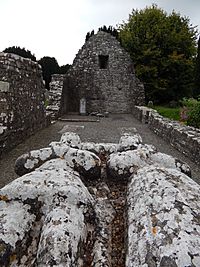James Bathe facts for kids
James Bathe (around 1500–1570) was an important Irish judge during the time of the Tudor kings and queens. He was famous for being the Chief Baron of the Irish Exchequer for 30 years. This meant he was the main judge in charge of the King's or Queen's money and taxes in Ireland. He served under four different rulers. James Bathe was also the grandfather of the first Earl of Roscommon and a well-known music expert named William Bathe.
Early Life
James Bathe was born in Beshellstown, Clonalvy, County Meath. His family, the Bathes, were an Anglo-Irish family, meaning they were English but had lived in Ireland for a long time. Their main home was Athcarne Castle, near Duleek. They had owned land in Rathfeigh since about 1400.
Many members of the Bathe family were important in law. For example, Sir Thomas Bathe was an earlier Chief Baron, and John Bathe was a Chief Justice. In 1522, James Bathe began studying law at a place called Middle Temple in England. In 1524, he was even in charge of the fun events there, known as the Master of the Revels.
His Work as a Judge
Early in his career, James Bathe was a strong supporter of Gerald FitzGerald, 9th Earl of Kildare, a powerful Irish leader. In 1525, while visiting England, James gave King Henry VIII a book he had written. The book was about how to improve the way Ireland was governed.
This book made a powerful family, the Cowleys, upset. Robert Cowley, the head of that family, told Cardinal Wolsey (a very important advisor to the King) that Bathe's book was really just a way to help Kildare get back into power. Kildare was not in favor with the King at that time. Cowley said Bathe knew nothing about Ireland and should be told off for being so bold.
James Bathe almost got into trouble during the rebellion led by Silken Thomas. Not only had he been loyal to Thomas's father, but he was also friends with some of the rebels. He had also recently married the daughter of John Burnell, one of the rebellion's leaders. Robert Cowley and his son Walter Cowley kept attacking Bathe, saying he was not fit for any government job because his actions were "disagreeable to the duty of a true subject." This was likely an accusation of disloyalty during the rebellion.
Luckily for Bathe, he had powerful friends, like Thomas St. Lawrence, who was the King's main lawyer in Ireland. Through St. Lawrence, Bathe gained the trust of the Lord Deputy, Leonard Grey, who was the King's representative in Ireland. Grey sent Bathe to report to Thomas Cromwell, another powerful advisor to the King, about the state of the Irish government. Bathe managed to stay safe even after Grey faced serious charges and was put to death in 1540. Bathe also played a big part in the Dissolution of the Monasteries, which was when the King took control of many religious buildings and their lands.
In 1540, James Bathe was made the Irish Chief Baron. He held this important job under every King and Queen of the Tudor family until he died in 1570. He was praised for his good service to the Crown, even though there were some complaints about him being slow to collect money for the government. He worked hard until his later years. However, as he got older, his health and mind started to fail. Many people complained that he was no longer able to do his job well. Sir Henry Sidney, the Lord Deputy of Ireland, wrote to Queen Elizabeth I in 1567 about how bad the King's money department (the Exchequer of Ireland) was because of Bathe's health.
Family and Property
James Bathe married twice. His first wife was Marjorie Ballard. After she died, he married Elizabeth Burnell. Elizabeth was the daughter of John Burnell and had been married before to Robert Barnewall. With Elizabeth, James had at least two children:
- John Bathe (died 1586) lived at Drumcondra Castle. He became the King's main lawyer in Ireland and was also in charge of the King's money department. John had eight children, including:
- William Bathe, who became a famous writer and musician.
- Jane Bathe (died before 1578) married Sir Lucas Dillon. Sir Lucas took over James Bathe's job as Chief Baron. Jane and Lucas had 12 children, including:
James Bathe became a very rich landowner in Dublin. He gained Drimnagh Castle through his marriage. Before 1560, he started building another castle at Drumcondra, which his son later finished. He also bought land north of the River Liffey. Like other landowners at the time, he sometimes got land in ways that were not always perfectly fair. In 1551, he and his wife received a royal pardon for taking over lands that should have gone to Edward Barnewall, Elizabeth's son from her first marriage. James's son John added a lot more land to the family's holdings, but most of it was lost by the next two generations.
James's wealth also attracted unwanted attention. In 1560, his home was robbed. A woman named Anne Walshe was found guilty of stealing a silver candlestick from his Drumcondra home. However, she later received a pardon for the crime.
His daughter Jane is buried next to her husband, Sir Lucas, at Newtown Abbey, near Trim, County Meath. Their tomb, which you can still see today, has a funny local nickname: "the tomb of the jealous man and woman." This name might come from the fact that the statues of Jane and Lucas on the tomb are separated by a sword of state. This might suggest they had some disagreements.



